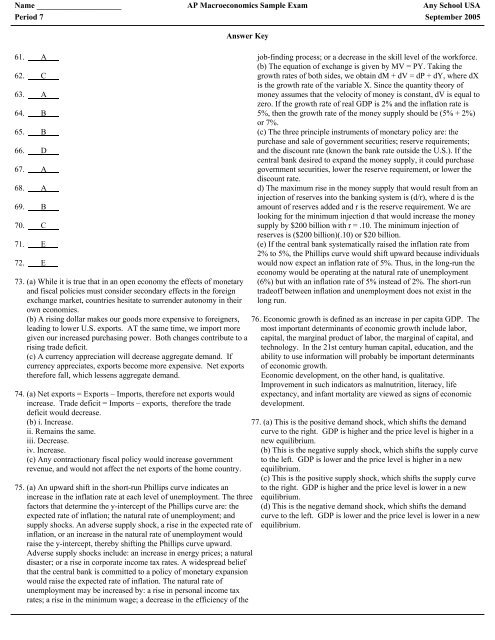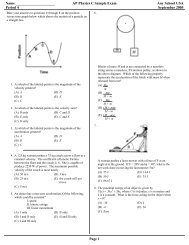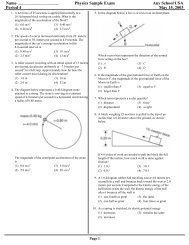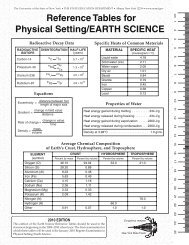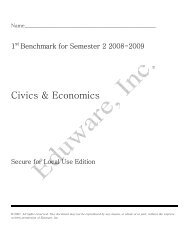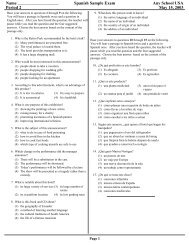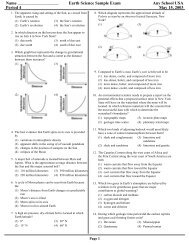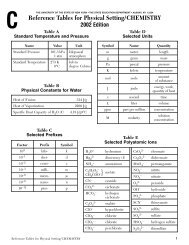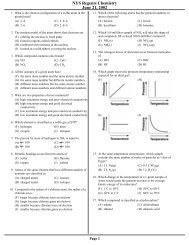The Wizard Test Maker - Eduware
The Wizard Test Maker - Eduware
The Wizard Test Maker - Eduware
Create successful ePaper yourself
Turn your PDF publications into a flip-book with our unique Google optimized e-Paper software.
Name _____________________ AP Macroeconomics Sample Exam Any School USA<br />
Period 7 September 2005<br />
61. A<br />
62. C<br />
63. A<br />
64. B<br />
65. B<br />
66. D<br />
67. A<br />
68. A<br />
69. B<br />
70. C<br />
71. E<br />
72. E<br />
Answer Key<br />
73. (a) While it is true that in an open economy the effects of monetary<br />
and fiscal policies must consider secondary effects in the foreign<br />
exchange market, countries hesitate to surrender autonomy in their<br />
own economies.<br />
(b) A rising dollar makes our goods more expensive to foreigners,<br />
leading to lower U.S. exports. AT the same time, we import more<br />
given our increased purchasing power. Both changes contribute to a<br />
rising trade deficit.<br />
(c) A currency appreciation will decrease aggregate demand. If<br />
currency appreciates, exports become more expensive. Net exports<br />
therefore fall, which lessens aggregate demand.<br />
74. (a) Net exports = Exports – Imports, therefore net exports would<br />
increase. Trade deficit = Imports – exports, therefore the trade<br />
deficit would decrease.<br />
(b) i. Increase.<br />
ii. Remains the same.<br />
iii. Decrease.<br />
iv. Increase.<br />
(c) Any contractionary fiscal policy would increase government<br />
revenue, and would not affect the net exports of the home country.<br />
75. (a) An upward shift in the short-run Phillips curve indicates an<br />
increase in the inflation rate at each level of unemployment. <strong>The</strong> three<br />
factors that determine the y-intercept of the Phillips curve are: the<br />
expected rate of inflation; the natural rate of unemployment; and<br />
supply shocks. An adverse supply shock, a rise in the expected rate of<br />
inflation, or an increase in the natural rate of unemployment would<br />
raise the y-intercept, thereby shifting the Phillips curve upward.<br />
Adverse supply shocks include: an increase in energy prices; a natural<br />
disaster; or a rise in corporate income tax rates. A widespread belief<br />
that the central bank is committed to a policy of monetary expansion<br />
would raise the expected rate of inflation. <strong>The</strong> natural rate of<br />
unemployment may be increased by: a rise in personal income tax<br />
rates; a rise in the minimum wage; a decrease in the efficiency of the<br />
job-finding process; or a decrease in the skill level of the workforce.<br />
(b) <strong>The</strong> equation of exchange is given by MV = PY. Taking the<br />
growth rates of both sides, we obtain dM + dV = dP + dY, where dX<br />
is the growth rate of the variable X. Since the quantity theory of<br />
money assumes that the velocity of money is constant, dV is equal to<br />
zero. If the growth rate of real GDP is 2% and the inflation rate is<br />
5%, then the growth rate of the money supply should be (5% + 2%)<br />
or 7%.<br />
(c) <strong>The</strong> three principle instruments of monetary policy are: the<br />
purchase and sale of government securities; reserve requirements;<br />
and the discount rate (known the bank rate outside the U.S.). If the<br />
central bank desired to expand the money supply, it could purchase<br />
government securities, lower the reserve requirement, or lower the<br />
discount rate.<br />
d) <strong>The</strong> maximum rise in the money supply that would result from an<br />
injection of reserves into the banking system is (d/r), where d is the<br />
amount of reserves added and r is the reserve requirement. We are<br />
looking for the minimum injection d that would increase the money<br />
supply by $200 billion with r = .10. <strong>The</strong> minimum injection of<br />
reserves is ($200 billion)(.10) or $20 billion.<br />
(e) If the central bank systematically raised the inflation rate from<br />
2% to 5%, the Phillips curve would shift upward because individuals<br />
would now expect an inflation rate of 5%. Thus, in the long-run the<br />
economy would be operating at the natural rate of unemployment<br />
(6%) but with an inflation rate of 5% instead of 2%. <strong>The</strong> short-run<br />
tradeoff between inflation and unemployment does not exist in the<br />
long run.<br />
76. Economic growth is defined as an increase in per capita GDP. <strong>The</strong><br />
most important determinants of economic growth include labor,<br />
capital, the marginal product of labor, the marginal of capital, and<br />
technology. In the 21st century human capital, education, and the<br />
ability to use information will probably be important determinants<br />
of economic growth.<br />
Economic development, on the other hand, is qualitative.<br />
Improvement in such indicators as malnutrition, literacy, life<br />
expectancy, and infant mortality are viewed as signs of economic<br />
development.<br />
77. (a) This is the positive demand shock, which shifts the demand<br />
curve to the right. GDP is higher and the price level is higher in a<br />
new equilibrium.<br />
(b) This is the negative supply shock, which shifts the supply curve<br />
to the left. GDP is lower and the price level is higher in a new<br />
equilibrium.<br />
(c) This is the positive supply shock, which shifts the supply curve<br />
to the right. GDP is higher and the price level is lower in a new<br />
equilibrium.<br />
(d) This is the negative demand shock, which shifts the demand<br />
curve to the left. GDP is lower and the price level is lower in a new<br />
equilibrium.


